ベクトルの内積
平面,空間ベクトル(教科書範囲) ★★
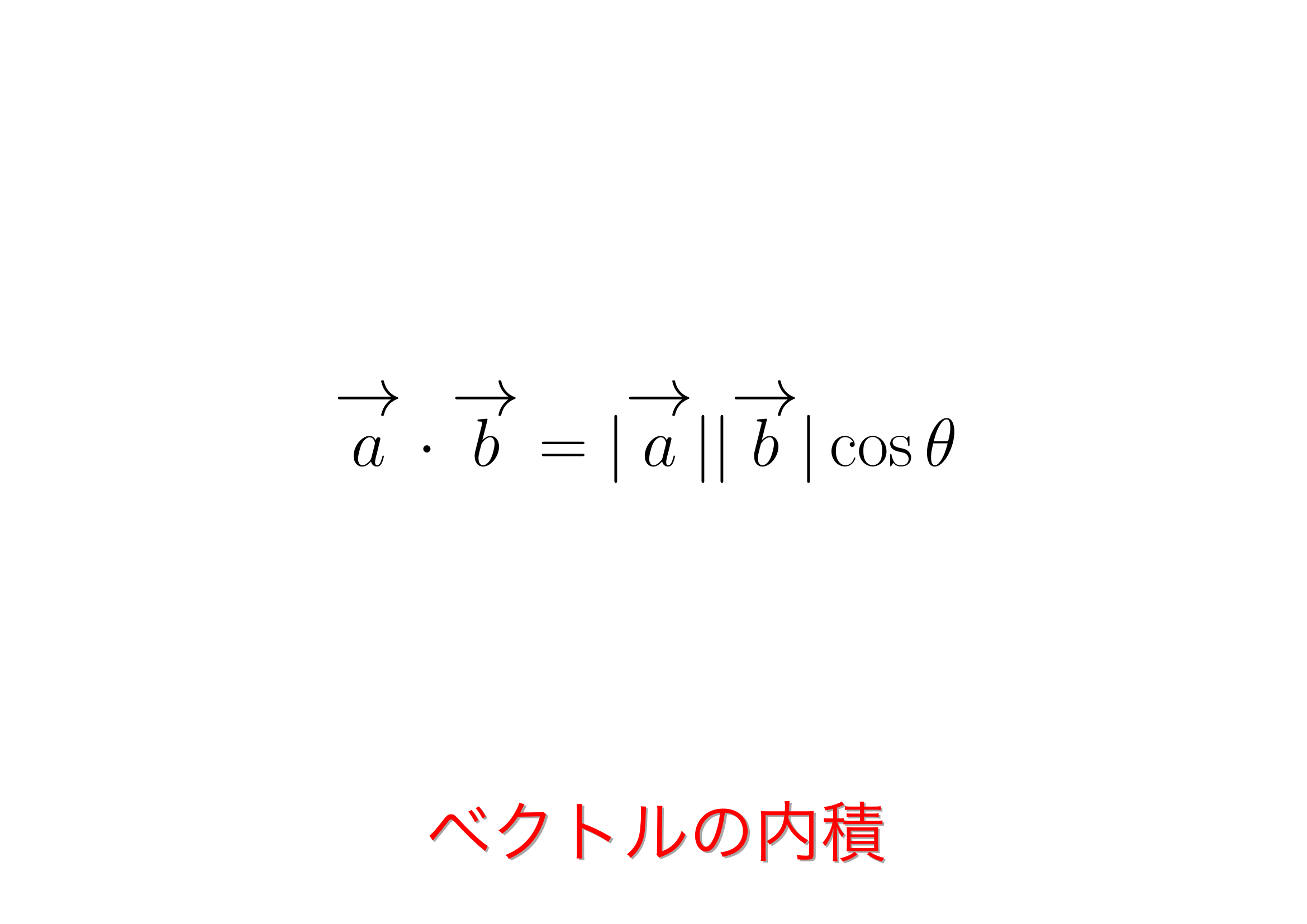
平面,空間ベクトル共通ページです.
ベクトルの内積を紹介します.突然登場する概念でここからベクトルが苦手になる人が多い印象です.このページで定義,成分表示,性質等一通り扱います.
平面ベクトル,空間ベクトルともに概念は同じです.平面ベクトル勉強中の場合は1章,3章のみご参照ください.
ベクトルの内積(平面ベクトル)
今までベクトルの演算,ベクトルの成分では,ベクトルの和を考えてきました.ここでベクトルに積はないのか?と思った方も多いと思います.
例えば $\overrightarrow{\mathstrut a}=\begin{pmatrix}a_{1} \\ a_{2}\end{pmatrix}$ と $\overrightarrow{\mathstrut b}=\begin{pmatrix}b_{1} \\ b_{2}\end{pmatrix}$ の成分同士をかけた $\begin{pmatrix}a_{1}b_{1} \\ a_{2}b_{2}\end{pmatrix}$ を積として定義していいかもしれませんが,特にここから発展して作れる有用な定理が少ないはずで,これを新しい概念として取り上げません.
代わりの積のような概念として,以下に内積の定義を紹介します.
ベクトルの内積の定義
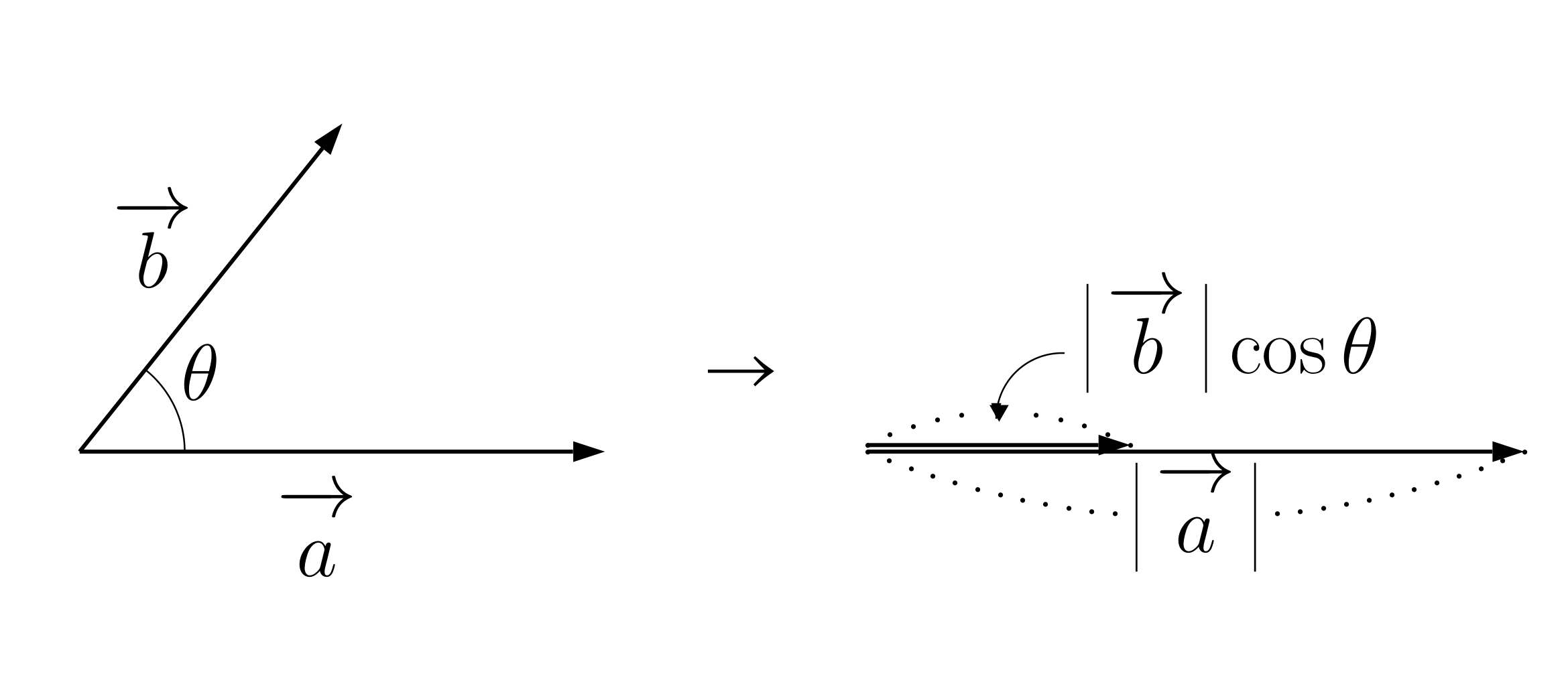
大きさが $0$ でない $\overrightarrow{\mathstrut a}$,$\overrightarrow{\mathstrut b}$ の始点同士を繋いでできるなす角を $\theta$ とする.内積 $\overrightarrow{\mathstrut a}\cdot\overrightarrow{\mathstrut b}$ を
$\boldsymbol{\overrightarrow{\mathstrut a}\cdot\overrightarrow{\mathstrut b}=|\overrightarrow{\mathstrut a}||\overrightarrow{\mathstrut b}|\cos\theta}$
で定義する.
※ $\overrightarrow{\mathstrut a}=\overrightarrow{\mathstrut 0}$ または $\overrightarrow{\mathstrut b}=\overrightarrow{\mathstrut 0}$ のときは $\overrightarrow{\mathstrut a}\cdot\overrightarrow{\mathstrut b}=0$ とする.
※ $\theta$ の範囲は $0\leqq\theta\leqq180^{\circ}$ です.
内積はベクトルではなく実数値(スカラー)であることに注意します.
ベクトルでは今後図形の問題を解いていきますが,その際に垂直や垂線が多数登場します.垂直であると $0$ になる指標があると便利で,有用な定理も多く作れます.
つまり
$\boldsymbol{\overrightarrow{\mathstrut a} \perp \overrightarrow{\mathstrut b} \ \Longrightarrow \ \overrightarrow{\mathstrut a}\cdot\overrightarrow{\mathstrut b}=|\overrightarrow{\mathstrut a}||\overrightarrow{\mathstrut b}|\cos90^{\circ}=0}$
垂直ならば内積が $0$ になります.
内積の成分表示
$\overrightarrow{\mathstrut a}=\begin{pmatrix}a_{1} \\ a_{2}\end{pmatrix}$,$\overrightarrow{\mathstrut b}=\begin{pmatrix}b_{1} \\ b_{2}\end{pmatrix}$ とすると
$\boldsymbol{\overrightarrow{\mathstrut a}\cdot\overrightarrow{\mathstrut b}=a_{1}b_{1}+a_{2}b_{2}}$
証明
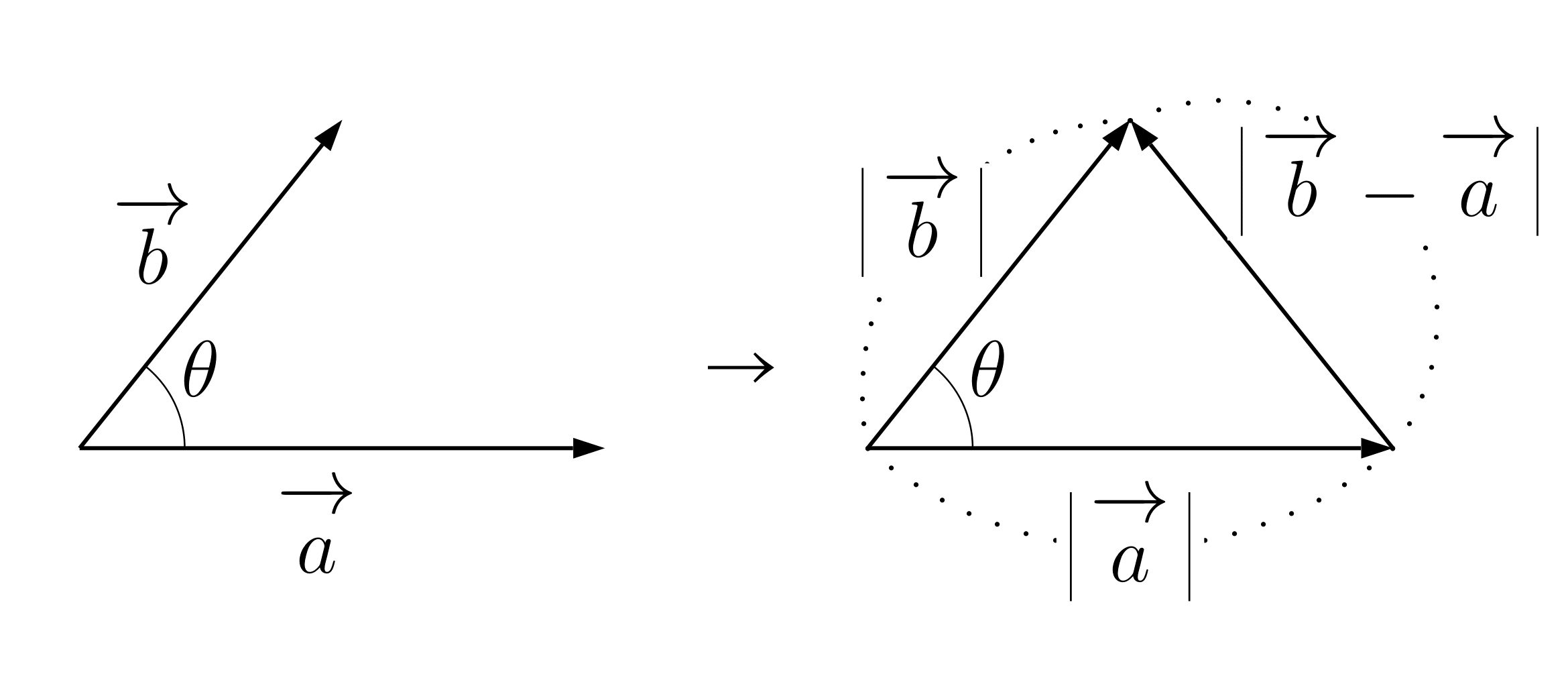
$\overrightarrow{\mathstrut a}\cdot\overrightarrow{\mathstrut b}$
$=|\overrightarrow{\mathstrut a}||\overrightarrow{\mathstrut b}|\cos\theta$
$=|\overrightarrow{\mathstrut a}||\overrightarrow{\mathstrut b}|\cdot \dfrac{|\overrightarrow{\mathstrut a}|^{2}+|\overrightarrow{\mathstrut b}|^{2}-|\overrightarrow{\mathstrut b}-\overrightarrow{\mathstrut a}|^{2}}{2|\overrightarrow{\mathstrut a}||\overrightarrow{\mathstrut b}|}$ ←余弦定理
$=\dfrac{a_{1}^{2}+a_{2}^{2}+b_{1}^{2}+b_{2}^{2}-\{(b_{1}-a_{1})^{2}+(b_{2}-a_{2})^{2}\}}{2}$
$=a_{1}b_{1}+a_{2}b_{2}$
内積を成分で表すと上のように綺麗に表現できます.
今後内積を多用するので,次では内積の性質を整理します.
内積の性質
Ⅰ $\overrightarrow{\mathstrut a}\cdot\overrightarrow{\mathstrut b}=\overrightarrow{\mathstrut b}\cdot\overrightarrow{\mathstrut a}$
Ⅱ $\overrightarrow{\mathstrut a}\cdot\overrightarrow{\mathstrut a}=|\overrightarrow{\mathstrut a}|^{2}$
Ⅲ $(k\overrightarrow{\mathstrut a})\cdot\overrightarrow{\mathstrut b}=\overrightarrow{\mathstrut a}\cdot(k\overrightarrow{\mathstrut b})=k(\overrightarrow{\mathstrut a}\cdot\overrightarrow{\mathstrut b})$ ( $k$ は実数)
Ⅳ $\overrightarrow{\mathstrut a}\cdot(\overrightarrow{\mathstrut b}+\overrightarrow{\mathstrut c})=\overrightarrow{\mathstrut a}\cdot\overrightarrow{\mathstrut b}+\overrightarrow{\mathstrut a}\cdot\overrightarrow{\mathstrut c}$
Ⅴ $(\overrightarrow{\mathstrut a}+\overrightarrow{\mathstrut b})\cdot \overrightarrow{\mathstrut c}=\overrightarrow{\mathstrut a}\cdot\overrightarrow{\mathstrut c}+\overrightarrow{\mathstrut b}\cdot\overrightarrow{\mathstrut c}$
※ Ⅳ,Ⅴを適用すると
$(\overrightarrow{\mathstrut a}+\overrightarrow{\mathstrut b})\cdot (\overrightarrow{\mathstrut c}+\overrightarrow{\mathstrut d})=\overrightarrow{\mathstrut a}\cdot\overrightarrow{\mathstrut c}+\overrightarrow{\mathstrut a}\cdot\overrightarrow{\mathstrut d}+\overrightarrow{\mathstrut b}\cdot\overrightarrow{\mathstrut c}+\overrightarrow{\mathstrut b}\cdot\overrightarrow{\mathstrut d}$
が示せるので,分配法則が適用できます.
証明
Ⅰ
$\overrightarrow{\mathstrut a}\cdot\overrightarrow{\mathstrut b}$
$=|\overrightarrow{\mathstrut a}||\overrightarrow{\mathstrut b}|\cos\theta$
$=|\overrightarrow{\mathstrut b}||\overrightarrow{\mathstrut a}|\cos\theta$
$=\overrightarrow{\mathstrut b}\cdot\overrightarrow{\mathstrut a}$
Ⅱ
$\overrightarrow{\mathstrut a}\cdot\overrightarrow{\mathstrut a}$
$=|\overrightarrow{\mathstrut a}||\overrightarrow{\mathstrut a}|\cos0$
$=|\overrightarrow{\mathstrut a}|^{2}$
以下 $\overrightarrow{\mathstrut a}=\begin{pmatrix}a_{1} \\ a_{2}\end{pmatrix}$,$\overrightarrow{\mathstrut b}=\begin{pmatrix}b_{1} \\ b_{2}\end{pmatrix}$,$\overrightarrow{\mathstrut c}=\begin{pmatrix}c_{1} \\ c_{2}\end{pmatrix}$ とする.
Ⅲ
$(k\overrightarrow{\mathstrut a})\cdot\overrightarrow{\mathstrut b}=\begin{pmatrix}ka_{1} \\ ka_{2}\end{pmatrix}\cdot\begin{pmatrix}b_{1} \\ b_{2}\end{pmatrix}=ka_{1}b_{1}+ka_{2}b_{2}$
$\overrightarrow{\mathstrut a}\cdot(k\overrightarrow{\mathstrut b})=\begin{pmatrix}a_{1} \\ a_{2}\end{pmatrix}\cdot\begin{pmatrix}kb_{1} \\ kb_{2}\end{pmatrix}=ka_{1}b_{1}+ka_{2}b_{2}$
$k(\overrightarrow{\mathstrut a}\cdot\overrightarrow{\mathstrut b})=k(a_{1}b_{1}+a_{2}b_{2})=ka_{1}b_{1}+ka_{2}b_{2}$
$\therefore \ (k\overrightarrow{\mathstrut a})\cdot\overrightarrow{\mathstrut b}=\overrightarrow{\mathstrut a}\cdot(k\overrightarrow{\mathstrut b})=k(\overrightarrow{\mathstrut a}\cdot\overrightarrow{\mathstrut b})$
Ⅳ,Ⅴ
$\overrightarrow{\mathstrut a}\cdot(\overrightarrow{\mathstrut b}+\overrightarrow{\mathstrut c})$
$=\begin{pmatrix}a_{1} \\ a_{2}\end{pmatrix}\cdot \begin{pmatrix}b_{1}+c_{1} \\ b_{2}+c_{2}\end{pmatrix}$
$=a_{1}(b_{1}+c_{1})+a_{2}(b_{2}+c_{2})$
$=a_{1}b_{1}+a_{2}b_{2}+a_{1}c_{1}+a_{2}c_{2}$
$=\overrightarrow{\mathstrut a}\cdot\overrightarrow{\mathstrut b}+\overrightarrow{\mathstrut a}\cdot\overrightarrow{\mathstrut c}$
$(\overrightarrow{\mathstrut a}+\overrightarrow{\mathstrut b})\cdot\overrightarrow{\mathstrut c}$
$=\begin{pmatrix}a_{1}+b_{1} \\ a_{2}+b_{2}\end{pmatrix}\cdot\begin{pmatrix}c_{1} \\ c_{2}\end{pmatrix}$
$=(a_{1}+b_{1})c_{1}+(a_{2}+b_{2})c_{2}$
$=a_{1}c_{1}+a_{2}c_{2}+b_{1}c_{1}+b_{2}c_{2}$
$=\overrightarrow{\mathstrut a}\cdot\overrightarrow{\mathstrut c}+\overrightarrow{\mathstrut b}\cdot\overrightarrow{\mathstrut c}$
内積の性質の性質を用い,以下のベクトルの和の大きさの2乗はこの先頻出ですが,証明が理解できてない人が多いので,是非理解しておきましょう.
ベクトルの和の大きさの2乗
$|\overrightarrow{\mathstrut a}+\overrightarrow{\mathstrut b}|^{2}=|\overrightarrow{\mathstrut a}|^{2}+2\overrightarrow{\mathstrut a}\cdot\overrightarrow{\mathstrut b}+|\overrightarrow{\mathstrut b}|^{2}$
証明
$|\overrightarrow{\mathstrut a}+\overrightarrow{\mathstrut b}|^{2}$
$=(\overrightarrow{\mathstrut a}+\overrightarrow{\mathstrut b})\cdot (\overrightarrow{\mathstrut a}+\overrightarrow{\mathstrut b})$ ←内積の性質Ⅱ
$=\overrightarrow{\mathstrut a}\cdot\overrightarrow{\mathstrut a}+\overrightarrow{\mathstrut a}\cdot\overrightarrow{\mathstrut b}+\overrightarrow{\mathstrut b}\cdot\overrightarrow{\mathstrut a}+\overrightarrow{\mathstrut b}\cdot\overrightarrow{\mathstrut b}$ ←分配法則
$=|\overrightarrow{\mathstrut a}|^{2}+2\overrightarrow{\mathstrut a}\cdot\overrightarrow{\mathstrut b}+|\overrightarrow{\mathstrut b}|^{2}$ ←内積の性質Ⅱ,Ⅰ
例えば $|\overrightarrow{\mathstrut a}-2\overrightarrow{\mathstrut b}|^{2}$ を出したければ,右辺の $\overrightarrow{\mathstrut b}$ に $(-2\overrightarrow{\mathstrut b})$ を代入して使います.
例題と練習問題(平面ベクトル)でこれらを使う練習をしていきます.
ベクトルの内積(空間ベクトル)
空間ベクトルでも,前章と同様です.
ベクトルの内積の定義

大きさが $0$ でない $\overrightarrow{\mathstrut a}$,$\overrightarrow{\mathstrut b}$ の始点同士を繋いでできるなす角を $\theta$ とする.内積 $\overrightarrow{\mathstrut a}\cdot\overrightarrow{\mathstrut b}$ を
$\boldsymbol{\overrightarrow{\mathstrut a}\cdot\overrightarrow{\mathstrut b}=|\overrightarrow{\mathstrut a}||\overrightarrow{\mathstrut b}|\cos\theta}$
で定義する.
※ $\overrightarrow{\mathstrut a}=\overrightarrow{\mathstrut 0}$ または $\overrightarrow{\mathstrut b}=\overrightarrow{\mathstrut 0}$ のときは $\overrightarrow{\mathstrut a}\cdot\overrightarrow{\mathstrut b}=0$ とする.
※ $\theta$ の範囲は $0\leqq\theta\leqq180^{\circ}$ です.
空間も平面と同じように
$\boldsymbol{\overrightarrow{\mathstrut a} \perp \overrightarrow{\mathstrut b} \ \Longrightarrow \ \overrightarrow{\mathstrut a}\cdot\overrightarrow{\mathstrut b}=|\overrightarrow{\mathstrut a}||\overrightarrow{\mathstrut b}|\cos90^{\circ}=0}$
垂直ならば内積が $0$ になります.
内積の成分表示
$\overrightarrow{\mathstrut a}=\begin{pmatrix}a_{1} \\ a_{2} \\ a_{3}\end{pmatrix}$,$\overrightarrow{\mathstrut b}=\begin{pmatrix}b_{1} \\ b_{2} \\ b_{3}\end{pmatrix}$ とすると
$\boldsymbol{\overrightarrow{\mathstrut a}\cdot\overrightarrow{\mathstrut b}=a_{1}b_{1}+a_{2}b_{2}+a_{3}b_{3}}$
証明

$\overrightarrow{\mathstrut a}\cdot\overrightarrow{\mathstrut b}$
$=|\overrightarrow{\mathstrut a}||\overrightarrow{\mathstrut b}|\cos\theta$
$=|\overrightarrow{\mathstrut a}||\overrightarrow{\mathstrut b}|\cdot \dfrac{|\overrightarrow{\mathstrut a}|^{2}+|\overrightarrow{\mathstrut b}|^{2}-|\overrightarrow{\mathstrut b}-\overrightarrow{\mathstrut a}|^{2}}{2|\overrightarrow{\mathstrut a}||\overrightarrow{\mathstrut b}|}$ ←余弦定理
$=\dfrac{a_{1}^{2}+a_{2}^{2}+a_{3}^{2}+b_{1}^{2}+b_{2}^{2}+b_{3}^{2}-\{(b_{1}-a_{1})^{2}+(b_{2}-a_{2})^{2}+(b_{3}-a_{3})^{2}\}}{2}$
$=a_{1}b_{1}+a_{2}b_{2}+a_{3}b_{3}$
空間の場合も内積を綺麗に表現できます.
内積の性質も平面と同様です.
内積の性質
Ⅰ $\overrightarrow{\mathstrut a}\cdot\overrightarrow{\mathstrut b}=\overrightarrow{\mathstrut b}\cdot\overrightarrow{\mathstrut a}$
Ⅱ $\overrightarrow{\mathstrut a}\cdot\overrightarrow{\mathstrut a}=|\overrightarrow{\mathstrut a}|^{2}$
Ⅲ $(k\overrightarrow{\mathstrut a})\cdot\overrightarrow{\mathstrut b}=\overrightarrow{\mathstrut a}\cdot(k\overrightarrow{\mathstrut b})=k(\overrightarrow{\mathstrut a}\cdot\overrightarrow{\mathstrut b})$ ( $k$ は実数)
Ⅳ $\overrightarrow{\mathstrut a}\cdot(\overrightarrow{\mathstrut b}+\overrightarrow{\mathstrut c})=\overrightarrow{\mathstrut a}\cdot\overrightarrow{\mathstrut b}+\overrightarrow{\mathstrut a}\cdot\overrightarrow{\mathstrut c}$
Ⅴ $(\overrightarrow{\mathstrut a}+\overrightarrow{\mathstrut b})\cdot \overrightarrow{\mathstrut c}=\overrightarrow{\mathstrut a}\cdot\overrightarrow{\mathstrut c}+\overrightarrow{\mathstrut b}\cdot\overrightarrow{\mathstrut c}$
※ Ⅳ,Ⅴを適用すると
$(\overrightarrow{\mathstrut a}+\overrightarrow{\mathstrut b})\cdot (\overrightarrow{\mathstrut c}+\overrightarrow{\mathstrut d})=\overrightarrow{\mathstrut a}\cdot\overrightarrow{\mathstrut c}+\overrightarrow{\mathstrut a}\cdot\overrightarrow{\mathstrut d}+\overrightarrow{\mathstrut b}\cdot\overrightarrow{\mathstrut c}+\overrightarrow{\mathstrut b}\cdot\overrightarrow{\mathstrut d}$
が示せるので,分配法則が適用できます.
証明
Ⅰ
$\overrightarrow{\mathstrut a}\cdot\overrightarrow{\mathstrut b}$
$=|\overrightarrow{\mathstrut a}||\overrightarrow{\mathstrut b}|\cos\theta$
$=|\overrightarrow{\mathstrut b}||\overrightarrow{\mathstrut a}|\cos\theta$
$=\overrightarrow{\mathstrut b}\cdot\overrightarrow{\mathstrut a}$
Ⅱ
$\overrightarrow{\mathstrut a}\cdot\overrightarrow{\mathstrut a}$
$=|\overrightarrow{\mathstrut a}||\overrightarrow{\mathstrut a}|\cos0$
$=|\overrightarrow{\mathstrut a}|^{2}$
以下 $\overrightarrow{\mathstrut a}=\begin{pmatrix}a_{1} \\ a_{2} \\ a_{3}\end{pmatrix}$,$\overrightarrow{\mathstrut b}=\begin{pmatrix}b_{1} \\ b_{2}\\ b_{3}\end{pmatrix}$,$\overrightarrow{\mathstrut c}=\begin{pmatrix}c_{1} \\ c_{2}\\ c_{3}\end{pmatrix}$ とする.
Ⅲ
$(k\overrightarrow{\mathstrut a})\cdot\overrightarrow{\mathstrut b}=\begin{pmatrix}ka_{1} \\ ka_{2} \\ ka_{3}\end{pmatrix}\cdot\begin{pmatrix}b_{1} \\ b_{2} \\ b_{3}\end{pmatrix}=ka_{1}b_{1}+ka_{2}b_{2}+ka_{3}b_{3}$
$\overrightarrow{\mathstrut a}\cdot(k\overrightarrow{\mathstrut b})=\begin{pmatrix}a_{1} \\ a_{2} \\ a_{3}\end{pmatrix}\cdot\begin{pmatrix}kb_{1} \\ kb_{2} \\ kb_{3}\end{pmatrix}=ka_{1}b_{1}+ka_{2}b_{2}+ka_{3}b_{3}$
$k(\overrightarrow{\mathstrut a}\cdot\overrightarrow{\mathstrut b})=k(a_{1}b_{1}+a_{2}b_{2}+a_{3}b_{3})=ka_{1}b_{1}+ka_{2}b_{2}+ka_{3}b_{3}$
$\therefore \ (k\overrightarrow{\mathstrut a})\cdot\overrightarrow{\mathstrut b}=\overrightarrow{\mathstrut a}\cdot(k\overrightarrow{\mathstrut b})=k(\overrightarrow{\mathstrut a}\cdot\overrightarrow{\mathstrut b})$
Ⅳ,Ⅴ
$\overrightarrow{\mathstrut a}\cdot(\overrightarrow{\mathstrut b}+\overrightarrow{\mathstrut c})$
$=\begin{pmatrix}a_{1} \\ a_{2} \\ a_{3}\end{pmatrix}\cdot \begin{pmatrix}b_{1}+c_{1} \\ b_{2}+c_{2} \\ b_{3}+c_{3}\end{pmatrix}$
$=a_{1}(b_{1}+c_{1})+a_{2}(b_{2}+c_{2})+a_{3}(b_{3}+c_{3})$
$=a_{1}b_{1}+a_{2}b_{2}+a_{3}b_{3}+a_{1}c_{1}+a_{2}c_{2}+a_{3}c_{3}$
$=\overrightarrow{\mathstrut a}\cdot\overrightarrow{\mathstrut b}+\overrightarrow{\mathstrut a}\cdot\overrightarrow{\mathstrut c}$
$(\overrightarrow{\mathstrut a}+\overrightarrow{\mathstrut b})\cdot\overrightarrow{\mathstrut c}$
$=\begin{pmatrix}a_{1}+b_{1} \\ a_{2}+b_{2} \\ a_{3}+b_{3}\end{pmatrix}\cdot\begin{pmatrix}c_{1} \\ c_{2} \\ c_{3}\end{pmatrix}$
$=(a_{1}+b_{1})c_{1}+(a_{2}+b_{2})c_{2}+(a_{3}+b_{3})c_{3}$
$=a_{1}c_{1}+a_{2}c_{2}+a_{3}c_{3}+b_{1}c_{1}+b_{2}c_{2}+b_{3}c_{3}$
$=\overrightarrow{\mathstrut a}\cdot\overrightarrow{\mathstrut c}+\overrightarrow{\mathstrut b}\cdot\overrightarrow{\mathstrut c}$
前章で扱ったベクトルの和の大きさの2乗はもちろん空間でもまったく同様です.
例題と練習問題(空間ベクトル)でこれらを使う練習をしていきます.
例題と練習問題(平面ベクトル)
例題
例題
(1)1辺の長さが $2$ の正六角形がある.
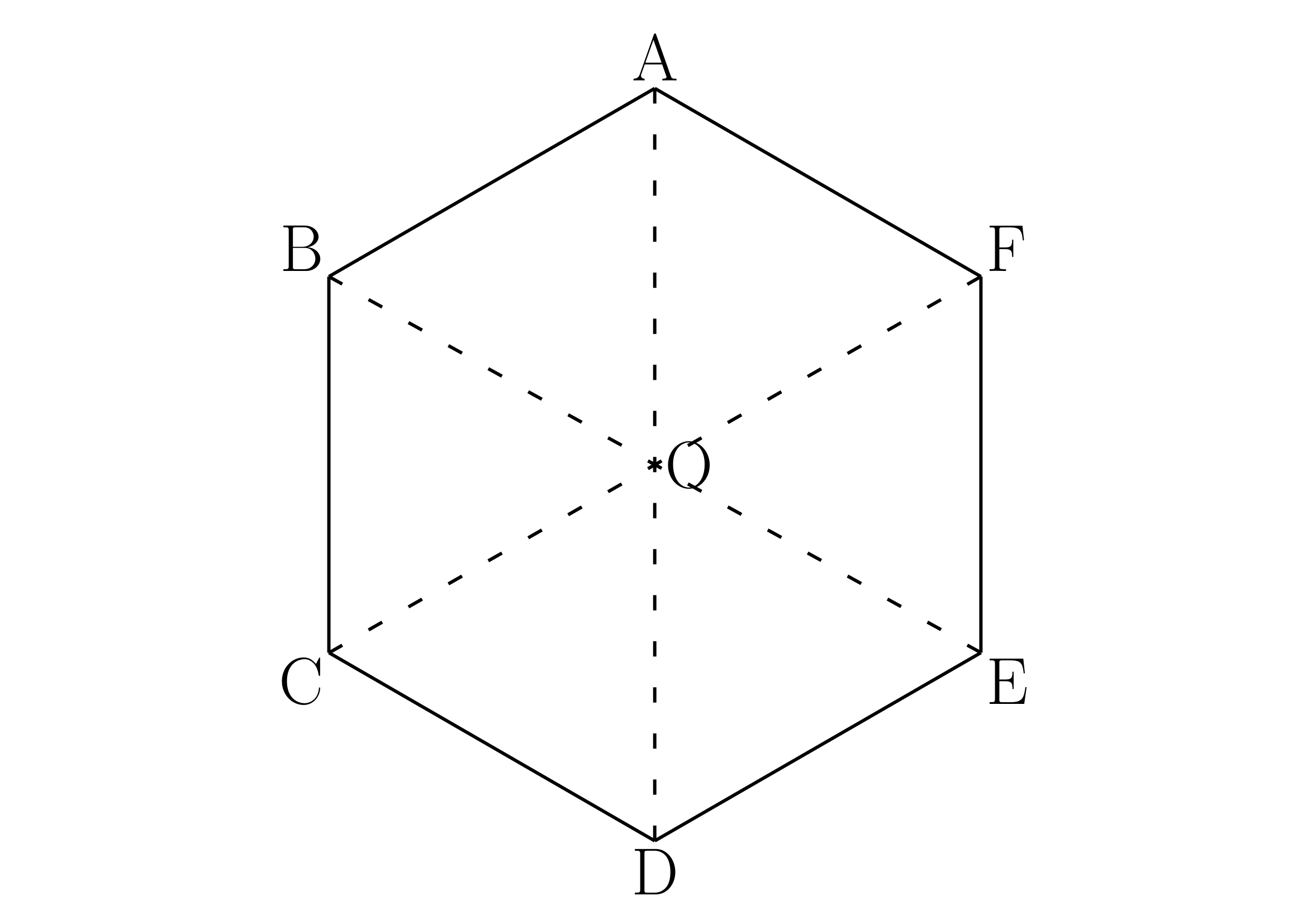
$\overrightarrow{\mathstrut \rm AB}\cdot \overrightarrow{\mathstrut \rm AF}$,$\overrightarrow{\mathstrut \rm OC}\cdot \overrightarrow{\mathstrut \rm AE}$ をそれぞれ求めよ.
(2) $\overrightarrow{\mathstrut a}=\begin{pmatrix}2 \\ 1 \end{pmatrix}$,$\overrightarrow{\mathstrut b}=\begin{pmatrix}3 \\ -6 \end{pmatrix}$ のなす角 $\theta$ を求めよ.
(3) $\overrightarrow{\mathstrut a}=\begin{pmatrix}3 \\ -4 \end{pmatrix}$ に垂直で,大きさが $10$ であるベクトルを求めよ.
(4) $|\overrightarrow{\mathstrut a}|=2$,$|\overrightarrow{\mathstrut b}|=3$,$\overrightarrow{\mathstrut a}\cdot \overrightarrow{\mathstrut b}=-1$ のとき,$|\overrightarrow{\mathstrut a}+2\overrightarrow{\mathstrut b}|$ の値を求めよ.
講義
(1) 始点同士を揃えてなす角を判定することに注意します.
(3) 垂直なベクトルは2つあることに注意です.
(4) ベクトルの大きさはまず2乗して計算します.
解答
(1)
$\overrightarrow{\mathstrut \rm AB}\cdot \overrightarrow{\mathstrut \rm AF}$
$=|\overrightarrow{\mathstrut \rm AB}||\overrightarrow{\mathstrut \rm AF}|\cos120^{\circ}$
$=2\cdot2\cdot\left(-\dfrac{1}{2}\right)$
$=\boldsymbol{-2}$
$\overrightarrow{\mathstrut \rm OC}\cdot \overrightarrow{\mathstrut \rm AE}$
$=\overrightarrow{\mathstrut \rm AB}\cdot \overrightarrow{\mathstrut \rm AE}$
$=\boldsymbol{0}$ ( $\therefore \ \angle {\rm BAE}=90^{\circ}$)
(2)
$\overrightarrow{\mathstrut a}\cdot\overrightarrow{\mathstrut b}$
$=2\cdot 3+1\cdot(-6)$
$=0$
$\therefore \ \boldsymbol{\theta=90^{\circ}}$
(3)
求めるベクトルを $\overrightarrow{\mathstrut b}=\begin{pmatrix}x \\ y \end{pmatrix}$ とおくと,$\overrightarrow{\mathstrut a}$,$\overrightarrow{\mathstrut b}$ は垂直なので
$\overrightarrow{\mathstrut a}\cdot\overrightarrow{\mathstrut b}=3x-4y=0$
$\overrightarrow{\mathstrut b}$ の大きさが $10$ より
$|\overrightarrow{\mathstrut b}|^{2}=x^{2}+y^{2}=100$
解くと $x=\pm8$,$y=\pm6$ (複号同順)
求めるベクトルは $\boldsymbol{\begin{pmatrix}\boldsymbol{\pm8} \\ \boldsymbol{\pm6}\end{pmatrix}}$ (複号同順)
(4)
$|\overrightarrow{\mathstrut a}+2\overrightarrow{\mathstrut b}|^{2}$
$=|\overrightarrow{\mathstrut a}|^{2}+4\overrightarrow{\mathstrut a}\cdot\overrightarrow{\mathstrut b}+4|\overrightarrow{\mathstrut b}|^{2}$ ←ベクトルの和の大きさの2乗
$=4-4+36$
$=36$
$\therefore \ \boldsymbol{|\overrightarrow{\mathstrut a}+2\overrightarrow{\mathstrut b}|=6}$
練習問題
練習
(1)1辺の長さが $2$ の正六角形がある.

$\overrightarrow{\mathstrut \rm DA}\cdot \overrightarrow{\mathstrut \rm BE}$ を求めよ.
(2) $\overrightarrow{\mathstrut a}=\begin{pmatrix}1 \\ 1 \end{pmatrix}$,$\overrightarrow{\mathstrut b}=\begin{pmatrix}\sqrt{6}+\sqrt{2} \\ \sqrt{6}-\sqrt{2} \end{pmatrix}$ のなす角 $\theta$ を求めよ.
(3) $\overrightarrow{\mathstrut a}=\begin{pmatrix}1 \\ 2 \end{pmatrix}$ に垂直である単位ベクトルを求めよ.
(4) $|\overrightarrow{\mathstrut a}|=|\overrightarrow{\mathstrut b}|=1$,$|\overrightarrow{\mathstrut a}+\overrightarrow{\mathstrut b}|=\sqrt{3}$ のとき,$\overrightarrow{\mathstrut a}$,$\overrightarrow{\mathstrut b}$ のなす角 $\theta$ を求めよ.
(5) $\triangle {\rm OAB}$ の3辺の長さを $\rm{OA}=4$,$\rm{OB}=5$,$\rm{AB}=6$ とし,$\overrightarrow{\mathstrut \rm OA}=\overrightarrow{\mathstrut a}$,$\overrightarrow{\mathstrut \rm OB}=\overrightarrow{\mathstrut b}$ とする.$\overrightarrow{\mathstrut a}\cdot\overrightarrow{\mathstrut b}$ を求めよ.
練習の解答
(1)
$\overrightarrow{\mathstrut \rm DA}=\begin{pmatrix}0 \\ 4 \end{pmatrix}$ とすれば $\overrightarrow{\mathstrut \rm BE}=\begin{pmatrix}2\sqrt{3} \\ -2 \end{pmatrix}$ より
$\overrightarrow{\mathstrut \rm DA}\cdot \overrightarrow{\mathstrut \rm BE}$
$=\begin{pmatrix}0 \\ 4 \end{pmatrix}\cdot \begin{pmatrix}2\sqrt{3} \\ -2 \end{pmatrix}$
$=\boldsymbol{-8}$
(2)
$\overrightarrow{\mathstrut a}\cdot\overrightarrow{\mathstrut b}=|\overrightarrow{\mathstrut a}||\overrightarrow{\mathstrut b}|\cos\theta$
より
$\sqrt{6}+\sqrt{2}+\sqrt{6}-\sqrt{2}=\sqrt{2}\cdot 4\cos\theta$
$\Longleftrightarrow \ \cos\theta=\dfrac{\sqrt{3}}{2}$
$\therefore \ \boldsymbol{\theta=30^{\circ}}$
(3)
求めるベクトルを $\overrightarrow{\mathstrut b}=\begin{pmatrix}x \\ y \end{pmatrix}$ とおくと,$\overrightarrow{\mathstrut a}$,$\overrightarrow{\mathstrut b}$ は垂直なので
$\overrightarrow{\mathstrut a}\cdot\overrightarrow{\mathstrut b}=x+2y=0$
$\overrightarrow{\mathstrut b}$ の大きさが $1$ より
$|\overrightarrow{\mathstrut b}|^{2}=x^{2}+y^{2}=1$
解くと $x=\pm \dfrac{2}{\sqrt{5}}$,$y=\mp \dfrac{1}{\sqrt{5}}$ (複号同順)
求めるベクトルは $\boldsymbol{\begin{pmatrix}\boldsymbol{\pm \dfrac{2}{\sqrt{5}}} \\ \boldsymbol{\mp \dfrac{1}{\sqrt{5}}}\end{pmatrix}}$ (複号同順)
(4)
$|\overrightarrow{\mathstrut a}+\overrightarrow{\mathstrut b}|=\sqrt{3}$ を両辺2乗すると
$|\overrightarrow{\mathstrut a}|^{2}+2\overrightarrow{\mathstrut a}\cdot\overrightarrow{\mathstrut b}+|\overrightarrow{\mathstrut b}|^{2}=3$
$\therefore \ \overrightarrow{\mathstrut a}\cdot\overrightarrow{\mathstrut b}=|\overrightarrow{\mathstrut a}||\overrightarrow{\mathstrut b}|\cos\theta=\cos\theta=\dfrac{1}{2}$
$\therefore \ \boldsymbol{\theta=60^{\circ}}$
(5)
$|\overrightarrow{\mathstrut \rm AB}|^{2}$
$=|\overrightarrow{\mathstrut \rm OB}-\overrightarrow{\mathstrut \rm OA}|^{2}$
$=|\overrightarrow{\mathstrut b}-\overrightarrow{\mathstrut a}|^{2}$
$=|\overrightarrow{\mathstrut b}|^{2}-2\overrightarrow{\mathstrut a}\cdot\overrightarrow{\mathstrut b}+|\overrightarrow{\mathstrut a}|^{2}$
$=25-2\overrightarrow{\mathstrut a}\cdot\overrightarrow{\mathstrut b}+16=36$
$\therefore \ \boldsymbol{\overrightarrow{\mathstrut a}\cdot\overrightarrow{\mathstrut b}=\dfrac{5}{2}}$
※ 余弦定理で $\cos {\rm \angle AOB}$ を出してから内積の定義で計算してもOKです.
例題と練習問題(空間ベクトル)
例題
例題
(1)
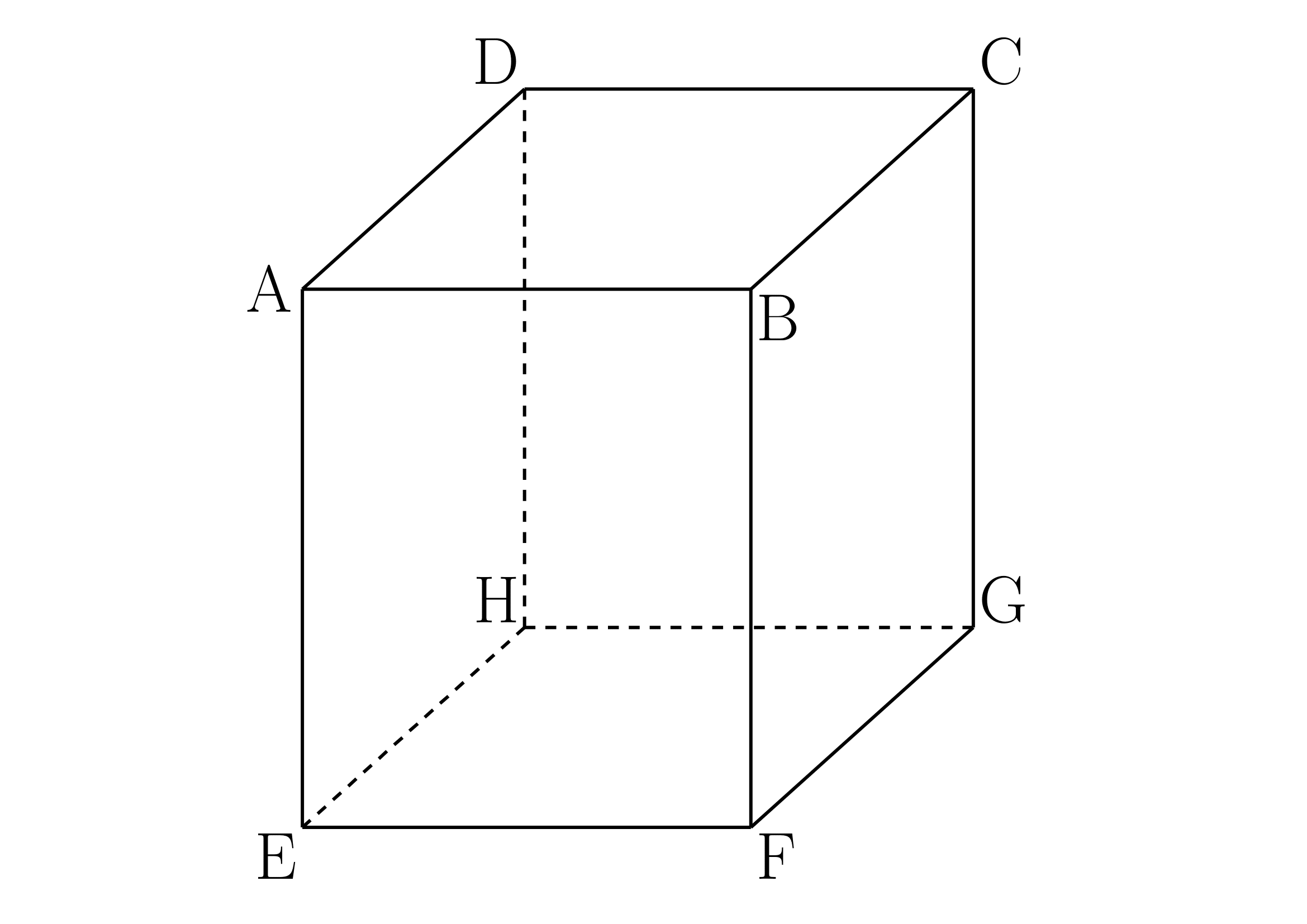
1辺の長さが $1$ の立方体 $\rm ABCD-EFGH$ について,$\overrightarrow{\mathstrut \rm AC}\cdot \overrightarrow{\mathstrut \rm AF}$,$\overrightarrow{\mathstrut \rm EC}\cdot \overrightarrow{\mathstrut \rm AG}$ をそれぞれ求めよ.
(2) $\overrightarrow{\mathstrut a}=\begin{pmatrix}-1 \\ 1 \\ 1\end{pmatrix}$,$\overrightarrow{\mathstrut b}=\begin{pmatrix}2 \\ -1 \\ 0\end{pmatrix}$ の両方に垂直で,$z$ 成分が負である単位ベクトルを求めよ.
講義
本質的に平面と同様です.
解答
(1)
$\overrightarrow{\mathstrut \rm AC}\cdot \overrightarrow{\mathstrut \rm AF}$
$=|\overrightarrow{\mathstrut \rm AB}||\overrightarrow{\mathstrut \rm AF}|\cos60^{\circ}$
$=\sqrt{2}\cdot\sqrt{2}\cdot\dfrac{1}{2}$
$=\boldsymbol{1}$
$\overrightarrow{\mathstrut \rm EC}=\begin{pmatrix}1 \\ 1 \\1\end{pmatrix}$ とすれば $\overrightarrow{\mathstrut \rm AG}=\begin{pmatrix}1 \\ 1 \\ -1 \end{pmatrix}$ より
$\overrightarrow{\mathstrut \rm EC}\cdot \overrightarrow{\mathstrut \rm AG}$
$=\begin{pmatrix}1 \\ 1 \\ 1\end{pmatrix}\cdot \begin{pmatrix}1 \\ 1 \\-1\end{pmatrix}$
$=\boldsymbol{1}$
※ 各頂点を座標設定し,ベクトルを成分表示すると内積が出しやすかったりします.
(2)
$\overrightarrow{\mathstrut a}$,$\overrightarrow{\mathstrut b}$ の両方に垂直なベクトルを $\overrightarrow{\mathstrut c}=\begin{pmatrix}x \\ y \\ -1\end{pmatrix}$ とおくと
$\begin{cases}\overrightarrow{\mathstrut a}\cdot \overrightarrow{\mathstrut c}=-x+y-1=0 \\ \overrightarrow{\mathstrut b}\cdot \overrightarrow{\mathstrut c}=2x-y=0\end{cases}$
$\therefore \ x=1,y=2$
$\overrightarrow{\mathstrut c}=\begin{pmatrix}1 \\ 2 \\ -1\end{pmatrix}$ より $|\overrightarrow{\mathstrut c}|=\sqrt{6}$ なので,求めるベクトルは
$\dfrac{1}{\sqrt{6}}\overrightarrow{\mathstrut c}=\begin{pmatrix}\boldsymbol{\dfrac{1}{\sqrt{6}}} \\ \boldsymbol{\dfrac{2}{\sqrt{6}}}\\ \boldsymbol{-\dfrac{1}{\sqrt{6}}}\end{pmatrix}$
※ $z$ 成分を仮に $-1$ と指定したことにより,文字を少なくして垂直なベクトルを算出しやすくしたのがこの解き方の特徴です.最後に指定した大きさに調整すればいいだけです.
練習問題
練習
(1) $\overrightarrow{\mathstrut a}=\begin{pmatrix}-3 \\ 1 \\ 2\end{pmatrix}$,$\overrightarrow{\mathstrut b}=\begin{pmatrix}-4 \\ 6 \\ -2\end{pmatrix}$ のなす角 $\theta$ を求めよ.
(2) $\overrightarrow{\mathstrut a}=\begin{pmatrix}1 \\ 0 \\ 2\end{pmatrix}$,$\overrightarrow{\mathstrut b}=\begin{pmatrix}1 \\ -1 \\ 3\end{pmatrix}$ の両方に垂直で,$x$ 成分が正である単位ベクトルを求めよ.
練習の解答
(1)
$\overrightarrow{\mathstrut a}\cdot\overrightarrow{\mathstrut b}=|\overrightarrow{\mathstrut a}||\overrightarrow{\mathstrut b}|\cos\theta$
より
$12+6-4=\sqrt{14}\cdot \sqrt{56}\cos\theta$
$\Longleftrightarrow \ \cos\theta=\dfrac{1}{2}$
$\therefore \ \boldsymbol{\theta=60^{\circ}}$
(2)
$\overrightarrow{\mathstrut a}$,$\overrightarrow{\mathstrut b}$ の両方に垂直ベクトルを $\overrightarrow{\mathstrut c}=\begin{pmatrix}1 \\ y \\ z\end{pmatrix}$ とおくと
$\begin{cases}\overrightarrow{\mathstrut a}\cdot \overrightarrow{\mathstrut c}=1+2z=0 \\ \overrightarrow{\mathstrut b}\cdot \overrightarrow{\mathstrut c}=1-y+3z=0\end{cases}$
$\therefore \ z=y=-\dfrac{1}{2}$
$\overrightarrow{\mathstrut c}=\begin{pmatrix}1 \\ -\dfrac{1}{2} \\ -\dfrac{1}{2}\end{pmatrix}$ より $|\overrightarrow{\mathstrut c}|=\dfrac{\sqrt{3}}{\sqrt{2}}$ なので,求めるベクトルは
$\dfrac{\sqrt{2}}{\sqrt{3}}\overrightarrow{\mathstrut c}=\begin{pmatrix}\boldsymbol{\dfrac{\sqrt{6}}{3}} \\ \boldsymbol{-\dfrac{\sqrt{6}}{6}} \\ \boldsymbol{-\dfrac{\sqrt{6}}{6}} \end{pmatrix}$
